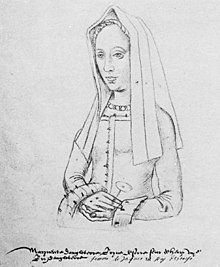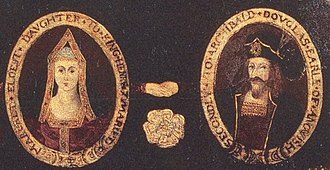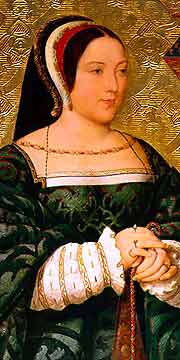Margaret Tudor
Margaret Tudor (born November 28, 1489 in London , † October 18, 1541 at Methven Castle in Perthshire ) was the eldest daughter of King Henry VII of England and his wife Elizabeth of York and the older sister of King Henry VIII of England and Queen Mary Tudor of France. Through her marriage to James IV , she became Queen of Scotland and mother of James V. After the death of her husband, she married Archibald Douglas, Earl of Angus , and gave birth to their only surviving daughter, Margaret Douglas . After her divorce from Angus, she married a third time, but her marriage to Henry Stewart, Lord Methven remained childless. Her grandchildren, Maria Stuart and Henry Stuart, Lord Darnley , derived their claim to the English throne from their descent from Margaret Tudor.
Life
childhood
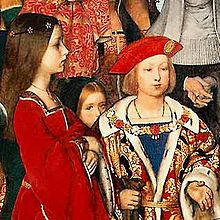
Margaret Tudor was born in the Palace of Westminster , the second child of Henry VII of England and Elizabeth of York . Her godmother was her grandmother Margaret Beaufort , after whom she was named and who would play an important role in the timing of their marriage. Unlike her older brother Arthur Tudor , who lived in his own household as the Prince of Wales , Margaret spent most of her childhood with her siblings, later King Henry VIII , her little sister Mary, and siblings Edmund and Elizabeth, who died young Tudor.
The little "high-born and excellent princess, Lady Margaret" made her first public appearance at the elevation of her brother Henry to Duke of York in 1494, one month before her fifth birthday. At the three-day tournament in honor of her brother, in her capacity as royal princess, she handed out the prizes to the winners: a gold ring with ruby for the joust winner and a gold ring with a diamond for the winner of the man-to-man fight. Contemporaries praised her as "the honored lady and beautiful young princess, the eldest daughter of our ruler, the king". For Margaret, this award meant much more than just an appearance in front of the people. She thus took her place as first lady of the court, just as her brother Heinrich took his place as first nobleman.
When she was eleven, she and her brother Heinrich received the scholar Erasmus of Rotterdam in their palace in Eltham. Margaret had another memorable public appearance at the wedding of her brother Arthur to the Spanish princess Catherine of Aragon . She and Heinrich performed several dances together as part of the court protocol. Heinrich, however, finally broke with the protocol while dancing with his sister by spontaneously throwing off his jacket and only dancing in his shirt.
Marriage to Jacob IV.
Since Margaret was six years old, England and Scotland had been negotiating a marriage between her and the Scottish King James IV. However, the negotiations were made considerably more difficult when the pretender to the throne Perkin Warbeck fled to Scotland after his unsuccessful invasion of Kent in 1495 and was received there in full honor by Jacob and to whose cousin Lady Catherine Gordon became engaged. Margaret's engagement to Jacob was of European importance, as Isabella of Castile and Ferdinand of Aragón only wanted to send their youngest daughter Catherine of Aragon to England as the bride of the heir to the throne when the island was pacified. The Spanish ambassador Pedro de Ayala eventually acted as a mediator between England and Scotland and negotiations resumed, particularly after Jakob Perkin got rid of Warbeck.
When they finally came to an agreement, however, Margaret was only nine years old and both her mother and grandmother Margaret Beaufort resolutely refused to marry off the small and petite girl for her age. Margaret Beaufort in particular knew from her own painful experience the catastrophic consequences of too early pregnancy. Henry VII entrusted Don Pedro:
“The queen and my mother are against the wedding. They say that if the marriage were to be concluded we would be obliged to send the princess to Scotland immediately and they fear that in that case the King of Scotland would not wait , but would injure her and endanger her health. "
Allegedly, even then, the king toyed with the idea of uniting England and Scotland under one crown through Margaret and Jacob's descendants, but if he actually expressed this idea, no one attached great importance to it, since Margaret's brothers Arthur Tudor and Heinrich were in the Succession to the throne.
When Margaret was thirteen, the proxy wedding finally took place on January 25, 1503 in Richmond . On behalf of the king, Patrick Hepburn, 1st Earl of Bothwell (German: Graf von Bothwell), married. Since Margaret was now officially Queen of Scotland, she was entitled to precedence at court over her brother Henry , who was rumored to burst into tears with anger. About six months later Margaret was sent to Scotland with a stately escort to marry Jacob. In Dalkeith , in August 1503, she met her husband for the first time, who paid her a brief surprise visit. The night after he left, a fire broke out in the stable and Margaret lost her favorite horses. At this news Jacob hurried back to comfort her.
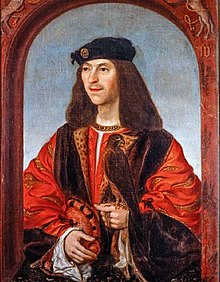
It was the beginning of a great affection between the couple, despite Jacob's notorious infidelity and his ultimate war against Margaret's brother Heinrich. A first blow to Margaret was the realization that Jacob's illegitimate children were being raised in her Stirling Castle . Since she did not become pregnant immediately, Jakob legitimized one of his sons in order to secure the succession. The couple had a total of six children, but only the fourth child, Jacob V , survived. Their two daughters died shortly after birth, their sons James, Arthur and Alexander were each only one year old. Margaret was so seriously ill after the birth of her first son that Jacob made a pilgrimage to the shrine of St. Ninian in Whithorn Priory to pray for the healing of his wife. Both adopted a new motto: God us defend - God protect us .
Despite the high hopes for peace between England and Scotland through Margaret's marriage to Jacob, the Scottish king still received envoys from France, which stirred up unrest in England over the Auld Alliance between France and Scotland. Henry VII increased tensions by arresting Jacob's cousin, the Earl of Arran, who was carrying messages between Scotland and France. Margaret got into the difficult position of having to represent both the interests of England and Scotland. After the death of her father, her brother Henry, now King of England, immediately went to war with the League of Cambrai against the hereditary enemy France, which caused outrage in Scotland. Margaret's relationship with Heinrich also deteriorated significantly when he refused to do justice to the last will of the late Crown Prince Arthur and later his late grandmother Margaret Beaufort, both of whom had bequeathed their personal fortune and valuable jewels to Margaret. Given the looming threat of war between England and Scotland, Henry cynically declared that Margaret would only preserve her inheritance if Jacob remained neutral.
Both her husband and brother demanded Margarets loyalty in the crisis situation and the conflict between her old and her new homeland weighed heavily on her, especially since Heinrich demanded her loyalty, but in return for years had only made empty promises. Finally war broke out between England and France and to the horror of the pregnant queen, Jakob, full of chivalrous protective behavior towards the French queen, decided to wage war against England, despite Margaret's desperate, almost hysterical pleas and her nightmares of his death. Since the League of Cambrai also acted with the blessing of the Pope, Jacob was excommunicated . As Margaret had feared, her husband lost his life in the Battle of Flodden Field against the English, led by Margaret's own sister-in-law Catherine of Aragon.
The king widow
After the death of his father, Margaret's one-year-old son succeeded the throne as Jacob V in 1513 . Since he was still a minor, the late king had decreed in his will that Margaret should take over the reign of her son, but only as long as she remained unmarried. Although her husband's death hit her hard, Margaret had little time to mourn. With the lost campaign and the death of the king, Scotland threatened to sink into violence and chaos. Therefore, one of Margaret's first measures was to issue a royal proclamation that put looting and rape on the same level as treason. When the Scottish Parliament was convened, the eight-month-pregnant queen won many hearts among the nobles, although a female regent, of English blood, was still mistrusted.
A little later Margaret gave birth to Jacob's last son, Alexander Stewart, Duke of Ross, who was also only a little older than a year. With Henry VIII and Catherine of Aragon still childless, Margaret and her children were the next heirs to the English throne. Perhaps this knowledge played an important role for Heinrich, who offered Margaret several times to come to England with her sons. After the heavy defeat against the English, the Scottish lords had already sent to France to call back John Stewart, Duke of Albany , who lived there. Since Stewart was third in line to the throne immediately after Margaret's sons, both Heinrich and Margaret mistrusted him. Heinrich harbored the fear that Albany, as male heir to the throne, could remove the two young heirs to the throne and proclaim himself king. Margaret, on the other hand, feared the opposite - that her son would lose the throne if he left the country. Because of this, she decided against coming to England. In addition to safeguarding her son's interests, Margaret worked for a more lasting peace with England.
The Scottish royal widow from the House of Tudor was a good match on the marriage market. For a time it was rumored in England that Louis XII. of France wanted to marry her, the future husband of Margaret's younger sister Mary Tudor . Lord Dacre, posted by Henry on the Scottish border, wrote to his master as Margaret was preparing for the birth of Alexander: “The Queen awaits her childbirth. If the French king wants to marry her, he can have her. ”However, this marriage did not take place. Instead, Margaret made a fatal mistake out of love that was to cost her the reign and guardianship of her sons.
Marriage to Archibald Douglas

Alone and completely on her own, Margaret looked for an alliance with one of the powerful Scottish aristocratic houses and fell in love with Archibald Douglas, Earl of Angus , who was about the same age and whom she secretly married on August 14, 1514 without the consent of her advisers and appointed co-regent . Due to this marriage, however, she lost the reign of her son. The nobles rebelled against a Douglas as the king's widow's husband, especially since the House of Douglas did not shy away from slapping an envoy from the council, stealing the imperial seal and thereby bringing the country to the brink of civil war. As a measure against this marriage and a possible war, the council appointed the Duke of Albany as regent of Scotland, who returned from France for this purpose.
Margaret had barricaded herself with Angus and her sons at Stirling Castle and was outraged to hear that Parliament had been convened twice in her absence. She turned down the offer to keep custody of her sons if she voluntarily resigned from the reign. As before, she invoked her royal dignity, although Parliament had already revoked her. Angry and helpless at the same time, she wrote to her brother:
“My opponents continue in their malice and parliament, usurping the authority of the king ... and calling us rebels; which is why I beg you to send your army quickly ... I will hold this castle with my children until I hear from you. "
Heinrich's hands were tied at this time, because at the same time his younger sister Mary Tudor was practically locked in her widow's room in France. Invading Scotland would have angered the new King Francis I and endangered Mary. With Albany's arrival, members of the Douglas House were imprisoned, leading Margaret to a spectacular and popular coup. Albany's embassy appeared in front of Edinburgh Castle to ceremonially request the handover of the guardianship of the young king. Margaret received the ambassadors at the gate, with her son by the hand, in front of a crowd that cheered the king. As soon as the embassy got close enough, Margaret lowered the portcullis so that she and her son could no longer be reached.
At the earliest opportunity she and her children fled to Stirling Castle. Her husband's relatives accompanied her as protectors, but abandoned her when Albany advanced with an army and cannons. Despite all the reluctance, Margaret had to leave her sons in Albany's care on August 20, 1515 and was finally forced to flee to England, heavily pregnant, without being able to take the most essential belongings with her. The fact that a former queen and princess by birth was separated from her children in this way, forced to flee and all of her belongings confiscated was an unprecedented scandal for European courts.
Sick and exhausted, Margaret Tudor gave birth to her only daughter Margaret Douglas in Harbottle Castle on the night of October 7-8, 1515 . Later, in a letter to her brother Henry VIII, she accused Albany of having triggered an early birth through his rude treatment: "Heavily pregnant and shortly before the birth, I had to flee for fear and concern for my life and go to the Kingdom of England. where I had a child eight days later, fourteen days too early, with serious damage and considerable dangers for me. ”She spent the entire next year as a guest in England at the court of her brother Heinrich, where her younger sister Mary has since gone France, who had recently secretly married Charles Brandon, 1st Duke of Suffolk , had returned. Thus there were three queens in England with Heinrich's wife Catherine of Aragon , all of whom had just given birth to children. During this time Katharina's only daughter Maria Tudor shared the apartments for the royal children with Margaret's daughter Margaret Douglas.
While Margaret spent a year relaxing with her family and enjoying the distractions of the English court, Henry's ministers Thomas Wolsey and Albany negotiated the terms of Margaret's return to Scotland. Albany proved cooperative and competent, contrary to Margaret's angry allegations. He agreed to return Margaret to Scotland and let her see her only surviving son, Jacob. He also agreed to pardon Angus and return his confiscated lands to him. This arrangement was one of the reasons why Angus did not accompany his wife and daughter to London, but stayed within the Scottish border. Nevertheless, neither Margaret nor Heinrich knew how to appreciate his behavior and Heinrich commented on it with a contemptuous "Done like a Scot - acted like a true Scot".
On her return to Scotland it quickly became apparent that Margaret's marriage to Angus was broken. He lived openly with his beloved, showered her with gifts he paid for Margaret's money, and separated the queen from her daughter. In 1521 he had to go into exile in France when Albany returned to assist Margaret. Since the Queen complained in 1524 that Douglas had not allowed her to see her daughter for three years, some historians believe that Archibald Douglas had taken the girl with him. Contrary to all promises of friendship to his sister, Henry VIII allowed Angus to return to Scotland in 1524. Immediately after his arrival, shortly after the opening of Parliament, Angus occupied the walls of Edinburgh with about 500 men in order to force Margaret to hand over her son, King James V, to him. To the horror of the English legation, Margaret responded to this provocation by firing the castle cannon at him. She then resolutely declared to her brother that she would not support any Scottish subject until the young King of Scotland asked for it.
Marriage to Henry Stewart
Margaret Tudor eventually sought annulment of her marriage to Archibald Douglas. However, this would have declared her daughter Margaret Douglas illegitimate, which not only meant a social stigma, but would also have legitimately excluded her from any inheritance. Her brother Heinrich was also appalled by the idea of a divorce and implored his sister in letters to respect the sacrament of marriage. It was probably an irony of fate that he later tried to divorce his wife Katharina von Aragón himself and accepted a break with the Catholic Church. Margaret, however, had fallen in love again, this time with Henry Stewart, later Lord Methven . Determined not to return to Angus, she once more shocked Europe by living with Stewart.
Archibald Douglas had meanwhile usurped the guardianship of Margaret's son Jacob V. The four earls, Arran, Argyll, Lennox, and Angus, were in turn responsible for the king, but when Angus' time had passed, he refused to release the king from his tutelage. In order to conceal this breach of law, he had the king declared to be of legal age on June 14, 1526, so that there was no longer any official guardianship. Margaret angrily gathered an army to free her son, only to find that Angus had forced her son to accompany him so that she would not dare attack him.
The incumbent Pope Clement VII finally declared the marriage between Margaret and Angus on March 11, 1527 invalid. However, he added a clause that secured the legitimacy of the now twelve-year-old Margaret Douglas. Children could remain legitimate despite being annulled if they were conceived in good faith . Clemens granted the cancellation on the grounds that Archibald Douglas had signed a preliminary contract to marry Lady Jane von Traquair before his marriage to Margaret Tudor. Such a preliminary contract was usually granted the status of a legally binding marriage. Since Margaret Tudor had not known about this preliminary contract, Margaret Douglas was conceived and born in good faith. In this way Margaret Tudor was able to obtain her cancellation without affecting the status of her daughter, who, as the sister of the Scottish King, was often called 'Princess of Scotland' both in England and by the Douglases. Her place in the English line of succession was thus secured.
Shortly after the annulment, Margaret secretly married Henry Stewart, who, however, was imprisoned shortly after Angus' marriage, allegedly because Margaret had married him without royal permission. A year later, Jakob finally managed to escape Angus' guardianship with the help of his mother, and chose his mother and new stepfather as his advisors. Archibald Douglas, who incurred the irreconcilable hatred of the king, had to flee to England and took his daughter Margaret Douglas with him, who was never to see her mother again. It soon became apparent, however, that Henry Stewart, now Lord Methven, was no better than Angus. He too had a mistress and stole Margaret's income from her lands. Angry and disappointed, she tried to obtain another divorce in 1538, which her son would not allow. Ultimately, she reconciled with her husband again.
The last few years

Throughout her life Margaret has always tried to maintain good relations between England and Scotland. Her diplomatic skills were put to another test when Jacob V discovered in the summer of 1532 that Henry VIII was still supporting Archibald Douglas and receiving him at court. The young king angrily declared that he would declare war on his uncle if he continued to support Angus. Margaret, who saw her many years of work in danger, offered herself as a mediator and finally succeeded in signing the Treaty of Berwick on May 12, 1534 , a peace treaty between England and Scotland in which Heinrich's meanwhile concluded marriage to Anne Boleyn was signed was recognized. In 1536 Margaret tried to persuade her son and brother to meet, but this did not take place because of Anne Boleyn's execution, among other things. In a conversation with the English Lord William Howard, Margaret confided to him: "I am tired of Scotland."
To Margaret's chagrin, she fell out with her son when he decided to marry his mistress Margaret Erskine . Their interference enraged Jakob, who was no longer willing to leave his fate to others and who always suspected his mother of spying for England. However, he had to recognize that Parliament was also against a marriage to Margaret Erskine. While Margaret continued to try to organize a meeting between him and Heinrich, Jakob instead traveled to France to court his new bride, Madeleine of France . In addition, he prevented Margaret from divorcing Henry Stewart and returning to England. Margaret felt she was being treated unfairly by her son because, in her opinion, he was not letting her live according to her rank, but that she was forced “to follow him like a poor noblewoman instead of being treated with respect and honor.” Only through the mediation of her second Daughter-in-law Marie de Guise improved the relationship between Margaret and Jakob and the queen's mother appeared more often at court, where she looked after her grandchildren, among other things.
death
Margaret Tudor died on October 18, 1541 at Methven Castle of complications from a stroke . On her deathbed, she asked her second husband Archibald Douglas for forgiveness for divorcing him. She validated him as her rightful husband and her marriage. It is not clear whether her motivation was actually repentance or simply an attempt to save the legitimacy of her daughter Margaret Douglas, who had fallen out of favor with her uncle Henry VIII and been declared illegitimate, which was tantamount to expulsion from the English succession to the throne. Furthermore, she bequeathed her jewels to her daughter, which Jacob V did not take into account, however, since the majority came from the Scottish crown treasure and thus belonged to the crown. She was buried in Perth . During the civil war, her grave was destroyed and her skeleton burned. Today only a stone slab in Perth reminds of Margaret Tudor's grave.
progeny
From her first marriage to King James IV:
- James Stuart, Duke of Rothesay (February 21, 1507 - February 27, 1508)
- Arthur Stuart, Duke of Rothesay (October 20, 1509 - July 14, 1510)
- James V , King of Scotland (April 10, 1512 - December 14, 1542)
- Alexander Stuart, Duke of Ross (April 30, 1514 - December 18, 1515)
- two daughters who died shortly after giving birth
From her second marriage to Archibald Douglas:
- Margaret Douglas (1515–1578) ⚭ 1544 Matthew Stewart, 4th Earl of Lennox
From her third marriage, she had a daughter who died in infancy.
Margaret Tudor's grandchildren are much more important than her children. The daughter of her son Jacob V, Maria Stuart , was to become the great rival and adversary of Margaret's niece Queen Elisabeth and, due to her descent from Margaret Tudor, lay claims to Elisabeth's throne. The son of their daughter Margaret Douglas, Henry Stewart, Lord Darnley , married his cousin Maria Stuart, so that the descendants of Margaret Tudor united their claim to the English throne and thus presented a dangerous Catholic alternative to Queen Elizabeth. The son from this connection, Margaret's great-grandson Jakob VI./I. , finally inherited the throne of childless Elizabeth, so that England and Scotland were ultimately united under one crown through Margaret's descendants.
Margaret Tudor in book and film
In her biographical novel The Thistle and the Rose , Jean Plaidy describes Margaret Tudor's life. Her life as Princess of England as well as her long and turbulent time in Scotland is summarized in a concise form. The main focus of the novel is on Margaret's relationship with her three husbands and their backgrounds. Jean Plaidy is largely based on historical facts, but also incorporates fictional elements into dialogues and thoughts, such as a confidential conversation between Margaret and Mary Tudor in which Mary, the older sister who fled to England , tells of her love for her newly wed husband Charles Brandon tells and mischievously advises her to look for a husband other than Archibald Douglas , as he did not accompany her to England.
Margaret Tudor has a very small supporting role in Philippa Gregory's novel The Constant Princess (dt. The eternal princess ), of the first years of the young Spanish princess Catherine of Aragon treated fictitiously at the English royal court. Thirteen-year-old Margaret is portrayed as a pampered princess who, after her engagement to the Scottish King, looks down contemptuously on her future sister-in-law and boasts of her future rank as Queen of Scotland. She is also mentioned in Diane Haeger's novel The Secret Bride: In the Court of King Henry VIII , which addresses Mary Tudor's secret love for Charles Brandon. Although never present in person, the rebellious Margaret often serves as a contrast to her more civilized sister Mary in conversations, but only until Mary decides how Margaret should marry the man she really loves.
In the first season of the television series The Tudors , Gabrielle Anwar played the role of Princess Margaret Tudor. However, this character was a fictional mixture of the sisters Margaret and Mary Tudor. Princess Margaret is shown as the older sister of the young King Henry , but after the death of her first husband, the King of Portugal, she marries her lover Charles Brandon, as historically the younger sister Mary Tudor did after the death of the King of France . The series does not go into the historical Margaret Tudor and her biography, although the Scottish King James V is also referred to as Henry's nephew.
See also
literature
- Maria Perry: Sisters to the King. The tumultuous lives of Henry VIII's sisters. Margaret of Scotland and Mary of France. André Deutsch, London 2002, ISBN 0-233-00208-1 .
Web links
Individual evidence
- ↑ David Starkey: Henry. Virtuous prince. Harper Perennial, London et al. 2009, ISBN 0-00-724772-9 , p. 97. "... the right high and mighty princess the lady Margaret".
- ^ Maria Perry: Sisters to the King. 2002, p. 19.
- ^ Maria Perry: Sisters to the King. 2002, p. 20. "... the redoubted lady, and fairest young princess, the eldest daughter to our sovereign lord the King".
- ↑ David Starkey: Henry. Virtuous prince. Harper Perennial, London et al. 2009, ISBN 0-00-724772-9 , p. 146.
- ^ Maria Perry: Sisters to the King. 2002, p. 27
- ^ Maria Perry: Sisters to the King. 2002, p. 28 “… The Queen and my mother are very much against the marriage. They say if the marriage were concluded we should be obliged to send the princess directly to Scotland, in which case they fear the King of Scotland would not wait , but injure her and endanger her health. "
- ^ Maria Perry: Sisters to the King. 2002, p. 36.
- ^ Maria Perry: Sisters to the King. 2002, p. 94.
- ^ Maria Perry: Sisters to the King. 2002, p. 92
- ^ Maria Perry: Sisters to the King. 2002, p. 105.
- ^ Maria Perry: Sisters to the King. 2002, p. 108
- ^ Dacre to Henry VIII. Carlisle Castle, April 8, 1514. , "... The Queen has taken her chamber in Stirling Castle. If the French King please to marry her he can have her. "
- ^ Maria Perry: Sisters to the King. 2002, p. 115.
- ↑ Frank Arthur Mumby: . The Youth of Henry VIII A Narrative in Contemporary Letters. Constable, London 1913, pp. 313-315, “My party-adversary continues in their malice and proceeds in their parliament, ursurping the king's authority ... reputing us as rebels; wherefore I beseech you that you would haste with your army ... I shall keep this castle with my children till I hear from you. "
- ^ Maria Perry: Sisters to the King. 2002, p. 175.
- ^ Maria Perry: Sisters to the King. 2002, p. 180.
- ^ Agnes Strickland: Lives of the Queens of Scotland and English Princesses connected with the Regal Succession of Great Britain. Volume 2. 3rd edition. William Blackwood & Sons, Edinburgh / London 1856, p. 251.
- ^ Richard Glen Eaves: Margaret (1489-1541) . In: Oxford Dictionary of National Biography . Oxford University Press 2004 Online Edition , accessed October 23, 2014
- ^ Richard Glen Eaves: Margaret (1489-1541) . In: Oxford Dictionary of National Biography . Oxford University Press 2004 Online Edition , accessed October 23, 2014
- ^ Maria Perry: Sisters to the King. 2002, p. 277.
- ^ Maria Perry: Sisters to the King. 2002, p. 291.
- ^ Maria Perry: Sisters to the King. 2002, p. 294.
- ^ Agnes Strickland: Lives of the Queens of Scotland and English Princesses connected with the Regal Succession of Great Britain. Volume 2. 3rd edition. William Blackwood & Sons, Edinburgh / London 1856, pp. 280–281.
- ^ Jean Plaidy : The Thistle and the Rose. Arrow, London 2006, ISBN 0-09-949325-X .
| predecessor | Office | Successor |
|---|---|---|
| Margaret of Denmark |
Queen Consort of Scotland 1503–1513 |
Madeleine of France |
| personal data | |
|---|---|
| SURNAME | Tudor, Margaret |
| BRIEF DESCRIPTION | English princess, Queen Consort of Scotland |
| DATE OF BIRTH | November 28, 1489 |
| PLACE OF BIRTH | London |
| DATE OF DEATH | October 18, 1541 |
| Place of death | Methven Castle , Perthshire |


